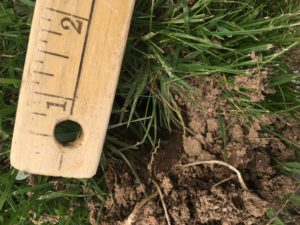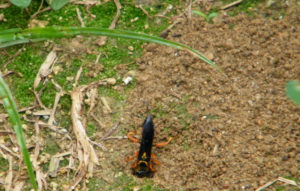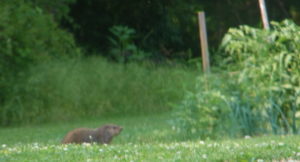What Kind Of Animal Makes Small Holes In Yard
en Español
El inglés es el idioma de control de esta página. En la medida en que haya algún conflicto entre la traducción al inglés y la traducción, el inglés prevalece.
Al hacer clic en el enlace de traducción se activa un servicio de traducción gratuito para convertir la página al español. Al igual que con cualquier traducción por Internet, la conversión no es sensible al contexto y puede que no traduzca el texto en su significado original. NC State Extension no garantiza la exactitud del texto traducido. Por favor, tenga en cuenta que algunas aplicaciones y/o servicios pueden no funcionar como se espera cuando se traducen.
English is the controlling language of this page. To the extent there is any conflict between the English text and the translation, English controls.
Clicking on the translation link activates a free translation service to convert the page to Spanish. As with any Net translation, the conversion is not context-sensitive and may not translate the text to its original meaning. NC State Extension does non guarantee the accuracy of the translated text. Please note that some applications and/or services may not role as expected when translated.
Collapse ▲
A common recurring question nosotros receive at the Caldwell Extension Center is "What is making holes in my lawn or mural?".

Sometimes mystery holes appear in the lawn. knowing the size, flavor, and characteristics tin narrow the listing of potential creatures. (picture by Ken Talbert)
When mystery holes appear in the backyard, I remember about the flavor, location, and size when formulating my answer. I actually enjoy postulating what might have caused these excavations. Mentally, I run through the listing trying to lucifer the testify with the possibilities.
Earthworms, especially the European night crawler, tin make fairly big holes in the footing. You may find 1-inch high piles of small, granular pellets of soil surrounding a pencil sized hole. These granular pellets are worm castings. These are mutual in leap and fall when soils are moist and temperatures are warm.
Many insects that transform from a larva to an developed in the soil leave get out holes when they emerge from the soil. I see these more in the late spring and early summer, particularly later a rain. These get out a nickel-size hole. These holes may be surrounded past minor mounds of loose soil and fecal pellets. The two all-time examples are cicadas and June beetles.
I accept seen many examples of lonely bees creating holes in the lawn or mural. These bees will make small holes in the soil. They will commonly select sites where vegetation is thin. The holes they create are chambers in which their young will develop. These holes are between ¼-and ½-inch wide. In that location can exist 100 or more solitary bees all nesting in close quarters.
Cicada killers are my favorite. They are actually a wasp. The female person digs a ¾-inch hole eighteen to 24 inches deep in the ground.

Cicada killers are impressive wasps. This female is earthworks a hole where she will lay eggs. These insects dig their tunnels tardily July to mid-August. (Picture by Jackie Nagy)
And then she captures a cicada and drags it downwardly the hole. She lays an egg, and her larva will feast on the cicada she has provisioned in her nest. Cicada killers adopt areas that are dry and bare or where grass is cut very brusque. One tell tale sign for cicada killer holes is they volition have all the excavated dirt mounded to one side of the hole. The wasps are also active for a few weeks during the day and are very noticable.
Crayfish are typically the culprit when the site is wet or the water tabular array is shut to the surface. These creatures build 2 inch to iv inch tall mud chimneys with and openings of about 1 inch in bore. The mounded mud is very distinctive.
Voles are pocket-sized rodents that do not hibernate. They are active all year long. They construct both surface runways every bit well equally underground tunnels. They consume a variety of plants, but they especially like hostas, roses, and nandinas. Tunnel entrances are 1 to 1½ inches in diameter and no mound of soil is present.
Squirrels and chipmunks make a hole similar to voles, simply squirrel holes are only about three inches deep. They bury and subsequently dig up nuts in the lawn and in mulched beds. The holes don't have excavated dirt at the top, just like vole holes.
Damage from skunks and raccoons occurs at night. They dig holes in lawns and gardens, looking for grubs and other insects. The holes are funnel-shaped with a 3 to 4 inch opening at the top. I had a colleague tell me ane fourth dimension that skunks or raccoons pulled upward new laid grass sod to get to insects that were below the new sod.
Rats may too tunnel in the soil. Rats disguise their tunnel entrances well-nigh shrubbery, forest piles, and sheds. Rat tunnel entrances can be as large equally 3 inches in diameter.
Groundhogs are a pest of vegetable gardens. They volition consume most anything that grows in a garden. They are active during the day.

Groundhogs are very subversive when they go into home gardens. They are a problem in the summer during the growing flavour. (Motion picture by Jackie Nagy)
Their burrow archway is usually 10 to 12 inches in bore and is distinguished by a large mound of excavated dirt at the chief entrance. Secondary holes will non accept whatsoever mounded soil effectually them.
Knowing what is making holes in the lawn helps to know if control is needed. Control strategies vary, depending on what is making the holes. Cicada killers and solitary bees can be controlled with a sprinkler. They do not like moisture sites. Watering encourages these beneficial insects to select some other site.
If wild fauna are the problem, the kickoff reaction should be to reduce the food, water, and shelter bachelor. This volition discourage their activity. This may include controlling the grub population to reduce the nutrient supply for skunks and raccoons.
Knowing what is causing the trouble makes the solution more than probable to work.
For answers to your agronomical questions, call the Caldwell County Extension Center at 828-757-1290 or visit u.s.a. online anytime at //caldwell.ces.ncsu.edu.
Source: https://caldwell.ces.ncsu.edu/2018/04/whats-making-this-hole-in-my-yard/
Posted by: allsupwhady1948.blogspot.com

0 Response to "What Kind Of Animal Makes Small Holes In Yard"
Post a Comment